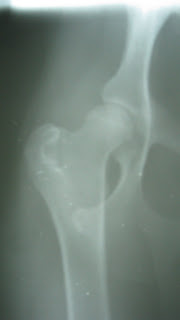
Gastric
dilatation (or stomach distension) and
volvulus (or twisting) is a deadly, fast moving emergency seen in large, deep-chested dogs. Some breeds prone to this emergency include Doberman
pinscher, German shepherd, Great Dane, Great Pyrenees,
Pyrenean mountain dog, Greyhound, Irish wolfhound, Mastiff, Saint Bernard, Scottish
deerhound, and Whippet. Some veterinary surgeons also add in
Weimaraner, Rottweiler, Gordon Setter, and Irish Setter. Not every individual within these breeds and dogs of another breed will encounter this. There is a great summary of this deadly disease at:
http://www.veterinarypartner.com/Content.plx?P=A&S=0&C=0&A=672.
The stomach fills up with gas causing it to become very enlarged and prone to twist. Once the stomach twists, vital blood vessels within the abdomen are strangulated causing an immediate cardiovascular crisis. The strangled vessels can send the dog into shock initially and if he/she survives this, the tissue begin to die from a lack of blood supply. Most owners never see this coming, but simply find their beloved pet weak, painful,
unresponsive, and possibly with an enlarged belly. These signs
constitute an immediate veterinary emergency. Time is now of the essence as the longer the vessels are twisted, the less chance of survival.
Upon arrival to your veterinarian he/she will take several vital steps. First, they will exam your pet and perform any necessary diagnostics.
Radiographs (
xrays) are the diagnostic test of choice. Above is a classic
radiograph of a 18 month old
Weimaraner that was described as unresponsive and weak for only 30 minutes prior to arrival. The stomach is twisted back on itself with severe gas distension and distension of multiple loops of intestines.
Once a diagnosis of
GDV is made (and most likely during the testing), the pet is stabilized with IV fluids to prevent/treat shock and the stomach is decompressed to release as much gas as necessary. However, to repair the twist and attempt to prevent future emergencies an
emergency surgery is necessary.
GDV surgeries are very risky, with mortality rates ranging from 25-35% before, during or after surgery. However, that provides a better chance than no surgery at all, since decompression alone has ~75% chance of
recurrence and mortality, while no treatment reaches ~100% mortality.
GDV surgery includes untwisting the stomach, assessing the vital organs for damage sustained, and attaching the stomach to the body wall (
gastropexy) to prevent rotation again.
Preventative
gastropexy is recommended by some in high risk breeds to prevent this emergency before it starts. In any case, remember that if your pet exhibits the above clinical signs and is one of the high risk breeds, do not hesitate to get them in as every second counts!
 Come in to CVC to order yours today!
Come in to CVC to order yours today!
 Come in to CVC to order yours today!
Come in to CVC to order yours today!








